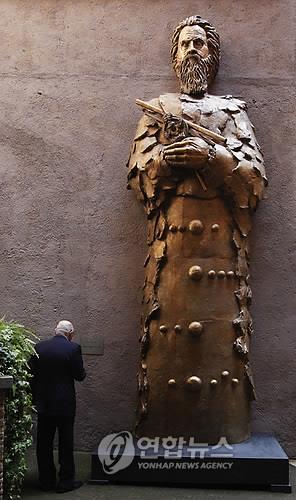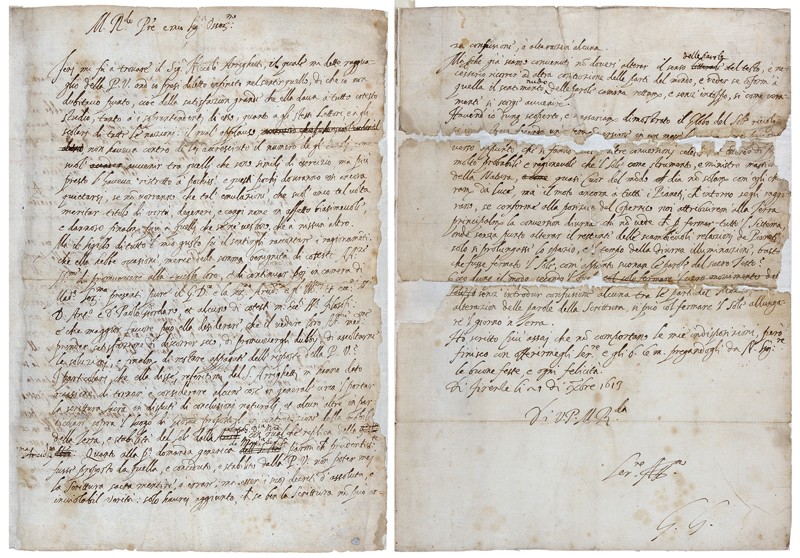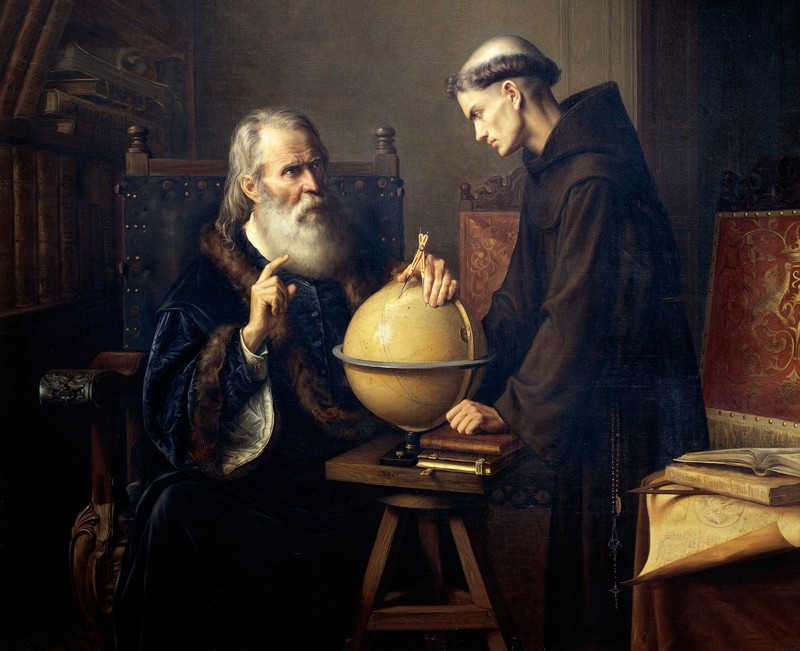(원문)
Exclusive: Document shows that the astronomer toned down the claims that triggered science history’s most infamous battle — then lied about his edits.

The original letter in which Galileo argued against the doctrine of the Roman Catholic Church has been rediscovered in London. Credit: The Royal Society
It had been hiding in plain sight. The original letter — long thought lost — in which Galileo Galilei first set down his arguments against the church’s doctrine that the Sun orbits the Earth has been discovered in a misdated library catalogue in London. Its unearthing and analysis expose critical new details about the saga that led to the astronomer’s condemnation for heresy in 1633.
The seven-page letter, written to a friend on 21 December 1613 and signed “G.G.”, provides the strongest evidence yet that, at the start of his battle with the religious authorities, Galileo actively engaged in damage control and tried to spread a toned-down version of his claims.
Many copies of the letter were made, and two differing versions exist — one that was sent to the Inquisition in Rome and another with less inflammatory language. But because the original letter was assumed to be lost, it wasn’t clear whether incensed clergymen had doctored the letter to strengthen their case for heresy — something Galileo complained about to friends — or whether Galileo wrote the strong version, then decided to soften his own words.
Galileo did the editing, it seems. The newly unearthed letter is dotted with scorings-out and amendments — and handwriting analysis suggests that Galileo wrote it. He shared a copy of this softened version with a friend, claiming it was his original, and urged him to send it to the Vatican.
The letter has been in the Royal Society’s possession for at least 250 years, but escaped the notice of historians. It was rediscovered in the library there by Salvatore Ricciardo, a postdoctoral science historian at the University of Bergamo in Italy, who visited on 2 August for a different purpose, and then browsed the online catalogue.
“I thought, ‘I can’t believe that I have discovered the letter that virtually all Galileo scholars thought to be hopelessly lost,’” says Ricciardo. “It seemed even more incredible because the letter was not in an obscure library, but in the Royal Society library.”
Ricciardo, together with his supervisor Franco Giudice at the University of Bergamo and science historian Michele Camerota of the University of Cagliari, describe the letter’s details and implications in an article in press at the Royal Society journal Notes and Records. Some science historians declined to comment on the finding before they had scrutinized the article. But Allan Chapman, a science historian at the University of Oxford, UK, and president of the Society for the History of Astronomy, says “it’s so valuable — it will allow new insights into this critical period”.
The first and last page of Galileo’s letter to his friend Benedetto Castelli. The last page shows his signature, “G. G.”.Credit: The Royal Society
Mixed messages
Galileo wrote the 1613 letter to Benedetto Castelli, a mathematician at the University of Pisa in Italy. In it, Galileo set out for the first time his arguments that scientific research should be free from theological doctrine (see ‘The Galileo affair’).
He argued that the scant references in the Bible to astronomical events should not be taken literally, because scribes had simplified these descriptions so that they could be understood by common people. Religious authorities who argued otherwise, he wrote, didn’t have the competence to judge. Most crucially, he reasoned that the heliocentric model of Earth orbiting the Sun, proposed by Polish astronomer Nicolaus Copernicus 70 years earlier, is not actually incompatible with the Bible.
Galileo, who by then was living in Florence, wrote thousands of letters, many of which are scientific treatises. Copies of the most significant were immediately made by different readers and widely circulated.
His letter to Castelli caused a storm.
Of the two versions known to survive, one is now held in the Vatican Secret Archives. This version was sent to the Inquisition in Rome on 7 February 1615, by a Dominican friar named Niccolò Lorini. Historians know that Castelli then returned Galileo’s 1613 letter to him, and that on 16 February 1615 Galileo wrote to his friend Piero Dini, a cleric in Rome, suggesting that the version Lorini had sent to the Inquisition might have been doctored. Galileo enclosed with that letter a less inflammatory version of the document, which he said was the correct one, and asked Dini to pass it on to Vatican theologians.
His letter to Dini complains of the “wickedness and ignorance” of his enemies, and lays out his concern that the Inquisition “may be in part deceived by this fraud which is going around under the cloak of zeal and charity”.
Galileo’s celestial ideas were deemed heretical and he lived his final nine years under house arrest.Credit: DeAgostini/Getty
At least a dozen copies of the version Galileo sent to Dini are now held in different collections.
The existence of the two versions created confusion among scholars over which corresponded to Galileo’s original.
Beneath its scratchings-out and amendments, the signed copy discovered by Ricciardo shows Galileo’s original wording — and it is the same as in the Lorini copy. The changes are telling. In one case, Galileo referred to certain propositions in the Bible as “false if one goes by the literal meaning of the words”. He crossed through the word “false”, and replaced it with “look different from the truth”. In another section, he changed his reference to the Scriptures “concealing” its most basic dogmas, to the weaker “veiling”.
This suggests that Galileo moderated his own text, says Giudice. To be certain that the letter really was written in Galileo’s hand, the three researchers compared individual words in it with similar words in other works written by Galileo around the same time.
Chance discovery
Ricciardo uncovered the document when he was spending a month this summer touring British libraries to study any handwritten comments that readers might have left on Galileo’s printed works. When his one day at the Royal Society was finished, he idly flicked through the online catalogue looking for anything to do with Castelli, whose writings he had recently finished editing.
One entry jumped out at him — a letter that Galileo wrote to Castelli. According to the catalogue, it was dated 21 October 1613. When Ricciardo examined it, his heart leapt. It appeared to include Galileo’s own signature, “G.G.”; was actually dated 21 December 1613; and contained many crossings out. He immediately realized the letter’s potential importance and asked for permission to photograph all seven pages.
“Strange as it might seem, it has gone unnoticed for centuries, as if it were transparent,” says Giudice. The misdating might be one reason that the letter has been overlooked by Galileo scholars, says Giudice. The letter was included in an 1840 Royal Society catalogue — but was also misdated there, as 21 December 1618.Another reason might be that the Royal Society is not the go-to place in the United Kingdom for this type of historical document, whose more natural home would have been the British Library.
The historians are now trying to trace how long the letter has been in the Royal Society library, and how it arrived there. They know that it has been there since at least the mid-eighteenth century, and they have found hints in old catalogues that it might even have been there a century or more earlier. The researchers speculate that it might have arrived at the society thanks to close connections between the Royal Society and the Academy of Experiments in Florence, which was founded in 1657 by Galileo’s students but fizzled out within a decade or so.
For now, the researchers are stunned by their find. “Galileo’s letter to Castelli is one of the first secular manifestos about the freedom of science — it’s the first time in my life I have been involved in such a thrilling discovery,” says Giudice.
갈릴레이, 종교재판 대비 자극적 단어 삭제한 ‘가짜 원본’ 돌려
http://www.yonhapnews.co.kr/bulletin/2018/09/26/0200000000AKR20180926046000009.HTML?input=1195m
400여년 전 지동설 지지 서한 원본 영국학술원 도서관서 발견

아시시에 있는 산타 마리아 델리 안젤리 성당 밖의 갈릴레이 동상 [EPA=연합뉴스]
종교재판을 받고 나오며 ‘그래도 지구는 돈다’는 말을 했다고 알려진 이탈리아의 천문학자 갈릴레오 갈릴레이가 가톨릭 교회의 천동설에 맞서 지동설에 대한 견해를 처음으로 밝힌 400여년 전의 편지 원문이 발견돼 이를 둘러싼 논란도 정리될 것으로 보인다.
이 편지는 종교재판에 제출된 것과 이보다 덜 자극적인 단어를 사용한 두 가지 버전이 나돌았지만 원본이 없어 어떤 것이 진짜인지를 놓고 의견이 분분했다.
26일 네이처(Nature)에 따르면 이탈리아 베르가모 대학의 과학 역사학자 살바토레 리치아르도 박사는 영국학술원 도서관에서 갈릴레이가 1613년 12월 21일 피사 대학의 수학자 베네데토 카스텔리에게 보낸 서한 원본을 발견했다.
총 7쪽으로 된 서한 마지막 장에는 ‘G.G.’라는 갈릴레이의 서명이 기입돼 있으며, 글씨체도 일치하는 것으로 확인됐다.
갈릴레이는 이 서한에서 성경은 천문학적 사건을 일반인이 이해할 수 있게 간략히 기술하고 있기 때문에 이를 글자 그대로 해석해서는 안 된다고 지적하면서 과학적 연구는 종교적 교리로부터 자유로워야 한다는 주장을 처음으로 했다.
당시 피렌체에 살던 갈릴레이는 수천통의 편지를 썼으며, 이 중 상당수는 과학논문으로 필사본이 곧바로 나도는 등 파급력이 대단했다고 한다. 갈릴레이가 카스텔리에게 보낸 서한도 마찬가지였다.
현재 교황청 비밀문서보관서에 소장된 서한은 1615년 2월 7일 도미니크회 수사 니콜로 로리니가 종교재판에 제출한 것으로 돼있다.

교황청이 공개한 갈릴레이 관련 문서들 [자료사진][EPA=연합뉴스]
역사학자들은 수학자 카스텔리가 갈릴레이의 서한을 로리니 수사에게 건넨 것으로 보고 있지만, 갈릴레이는 1615년 2월 16일 성직자 친구인 피에로 디니에게 보낸 서한에서 이 서한의 조작 가능성을 제기하며 원본이라고 주장하는 문서를 첨부했다.
이 문서는 로리니 수사가 종교재판에 제출한 것보다 순화된 단어를 사용하고 있으며, 갈릴레이는 적들의 “사악함과 무지”에 대한 불평을 늘어놓으며 원본 내용을 교황청에 전달해 줄 것을 부탁했다고 한다.
이렇듯 두 가지 버전이 나돌면서 갈릴레이의 진의가 어느 쪽에 있었는지를 놓고 의견이 갈렸지만 로리니 수사가 종교재판에 제출한 것과 같은 내용의 서한 원본이 발견됨으로써 이를 둘러싼 논란도 종지부를 찍게 됐다.
갈릴레이는 서한 원본에서 성경의 특정 입장에 대해 “거짓(false)”이라는 단어를 사용했다가 줄을 긋고 “진실과 달라 보이는(look different from the truth)”으로 수정했으며, 또 다른 한 부분에서는 “감추는(concealing)”이라는 단어 대신 어감이 약한 “가리는(veiling)”이라는 단어로 고쳐 썼다.
갈릴레이가 자신에 대한 종교재판에 대비하기 위해 원본의 자극적인 단어를 순화한 수정 서한을 만들어 돌린 셈이다.
갈릴레이는 이때 성서 내용과 모순되는 학설을 주장하거나 옹호하지 않는다는 서약을 하는 선에서 마무리돼 종교재판에는 회부되지 않았다. 그러나 1632년 ‘프톨레마이오스-코페르니쿠스 두 개의 주요 우주 체계에 대한 대화’를 출간한 뒤에는 결국 종교재판에 넘겨져 유죄판결을 받았으며 이후 죽을 때까지 9년간 가택연금 상태로 살았다.
그가 종교재판 뒤 ‘그래도 지구는 돈다’라는 말을 했다고 널리 알려져 있지만 실제 그런 말을 했는지는 확인되지 않았다는 것이 정설로 돼있다.
리치아르도 박사는 갈릴레이의 서한을 받은 인사들이 추가로 적어넣은 코멘트를 연구하다가 1840년대 소장 목록에 올라있던 문제의 서한을 우연히 발견했다.
목록에는 서한이 작성된 날짜도 1613년 10월 21일로 잘못 적혀 있었다고 한다.
이 서한은 갈릴레이의 제자들이 1657년 설립했다가 10여년 만에 사라진 피렌체의 ‘아카데미아델치멘토(Academy of Experiment)’와 영국학술원의 인연으로 영국에 넘겨졌다가 분류가 잘못되는 바람에 서고에서 빛을 보지 못한 것으로 추정된다.
리치아르도 박사는 이 서한의 내용과 의미를 자세히 기술한 논문을 영국학술원 저널 ‘노트와 기록(Notes and Records)’ 최신호에 실을 예정이다.

